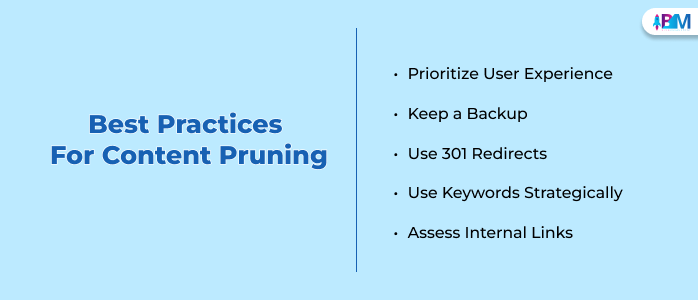It takes more than simply fresh content creation to keep a successful website up to date in the digital world. Periodically reviewing and optimizing already-existing information is also crucial.
Content pruning involves analyzing your content to identify underperforming or out-of-date sections and strategically deciding whether to update, combine, or eliminate them.
Proper execution of content trimming may greatly improve the functionality and search engine optimization of your website.
Why Content Pruning Matters

Here are a few of the top reasons why content pruning is important for your SEO efforts:
1. Enhanced User Experience
User experience enhancement is one of the main advantages of content trimming. Remember, users are always seeking relevant, high-quality content.
Your site may see greater bounce rates and less engagement if it is overflowing with out-of-date or repetitive content, which makes it harder for consumers to discover what they need.
You may simplify your website and make it easier for people to browse and discover important information by trimming content.
2. Improved Search Engine Results
Search engines want to provide consumers with the best and most relevant results possible. You may suffer from lower search engine rankings if the information on your website is old or of poor quality.
Content pruning ensures that only the most relevant information is left on your website, which can raise your site’s search engine rankings by increasing its authority and relevancy.
3. Making The Most Of The Crawl Budget
Each website has a crawl budget that search engines are limited to, so they can only index a particular number of pages in a given amount of time.
You may increase the likelihood that search engines will focus their crawl budget on your most essential pages and increase the likelihood that those pages will be indexed and ranked well by eliminating low-quality or irrelevant content.
Steps To Effective Content Pruning
Check out effective steps for content pruning:
1. Conduct A Content Audit
Conducting a comprehensive content audit is the first step in the content pruning process. This entails taking stock of all the information on your website and evaluating its effectiveness.
Page views, time on page, bounce rate, and conversion rates are important metrics to consider. Google Analytics and other SEO services like Ahrefs and SEMrush can offer insightful data about your content’s performance.
2. Recognize Poor Content
Finding underperforming content is the next step once you have a clear view of how well your content is performing. Seek out old or outdated content, high bounce rates, or low traffic content. Consider the content’s relevancy to your audience and present business objectives as well. Choose whether to update, combine, or delete each underperforming piece of content:
Update: If the text is out of date but still pertinent, consider adding fresh details, enhanced images, and keyword optimization.
Combine: If you have several articles covering related subjects, you might choose to combine them into one long post. This may reduce repetition and provide your readers with more content.
Delete: It could be appropriate to remove information from your website if it is no longer relevant or cannot be improved. Make sure you put up the proper redirects to preserve current traffic and prevent broken links.
3. Optimize Retained Content
Make sure the content you choose to retain is completely optimized. This includes making sure all links are working, updating keywords, and improving readability and meta descriptions. Additionally, you may enhance SEO performance and user engagement with well-designed images and a clear structure.
4. Evaluate And Modify
Pruning content is an ongoing process. Keep a close eye on how well your content is performing and modify your plan as necessary. This practice of ongoing enhancement aids in keeping your website’s quality and relevancy at a high level.
Best Practices For Content Pruning

Here are some of the industry-best strategies for content pruning:
1. Prioritize User Experience
When you edit material, always remember who your audience is. The primary goal is to provide useful and relevant information that satisfies their requirements.
Use analytics, comments, and surveys to interact with your audience and get their opinions and ideas. Feedback like this may be used to determine what content needs to be updated or removed.
By concentrating on the user experience, you may increase overall user happiness and engagement while ensuring that your website continues to be a reliable and authoritative source of information.
2. Keep A Backup
Before making any changes, make sure you have a complete backup of your content. This will give you a history of your site’s development and enable you to restore any content if necessary.
Frequent backups are an essential safety precaution, guarding against unintentional changes or deletions that might harm your website. Having backups gives you comfort and consistency, letting you explore and improve your material without worrying about it being lost forever.
3. Use 301 Redirects
Use 301 redirects to point visitors and search engines to the most pertinent information that remains after removing content. This avoids 404 errors, which can negatively impact user experience and search engine results, and helps maintain any SEO value from the removed pages.
By using 301 redirects, you may preserve the integrity of your website’s architecture and your users’ happiness by making sure that any inbound links or bookmarks to the outdated material still point to relevant content.
4. Use Keywords Strategically
Consider your keyword approach carefully as you edit and optimize your material. Make sure the keywords you use for your content are relevant to your audience and follow the latest SEO best practices.
Using keyword research, find high-performing words and phrases, then organically include them in your writing. Using keywords strategically guarantees that your content satisfies the demands and expectations of your target audience and increases your search engine exposure.
5. Assess Internal Links
Content pruning may impact your internal linking structure. To ensure that users and search engines have an easy time navigating your website, update or remove any internal links that lead to merged or removed information.
Routinely assessing and modifying your internal links supports maintaining a consistent site design and effectively distributing link equity.
This technique improves user experience and aids search engines in efficiently crawling and indexing your website by making sure all links go to worthwhile, relevant content.
Conclusion
Content pruning is an essential approach for running a high-quality, productive website. By routinely analyzing and refining your content, you may boost SEO performance, optimize user experience, and make better use of your site’s resources.
Content pruning may seem intimidating, but it’s an investment worth making when you consider the advantages of a simplified, high-performing website. Your website’s performance and user happiness will skyrocket if you embrace this continuous process as an essential component of your digital strategy.
Read More:
